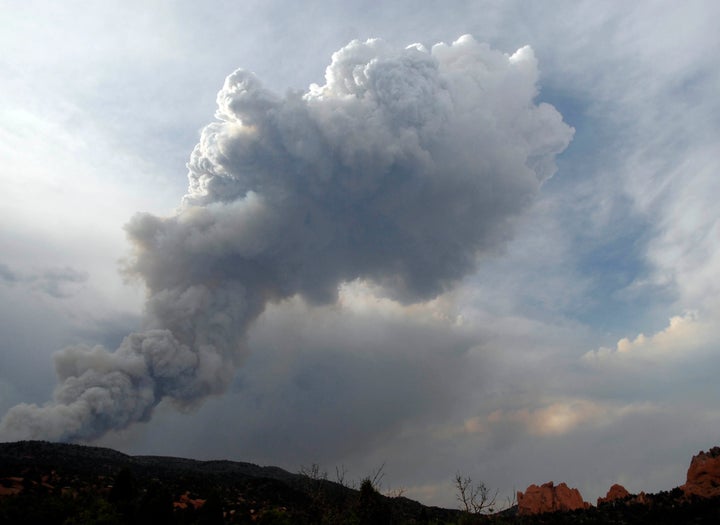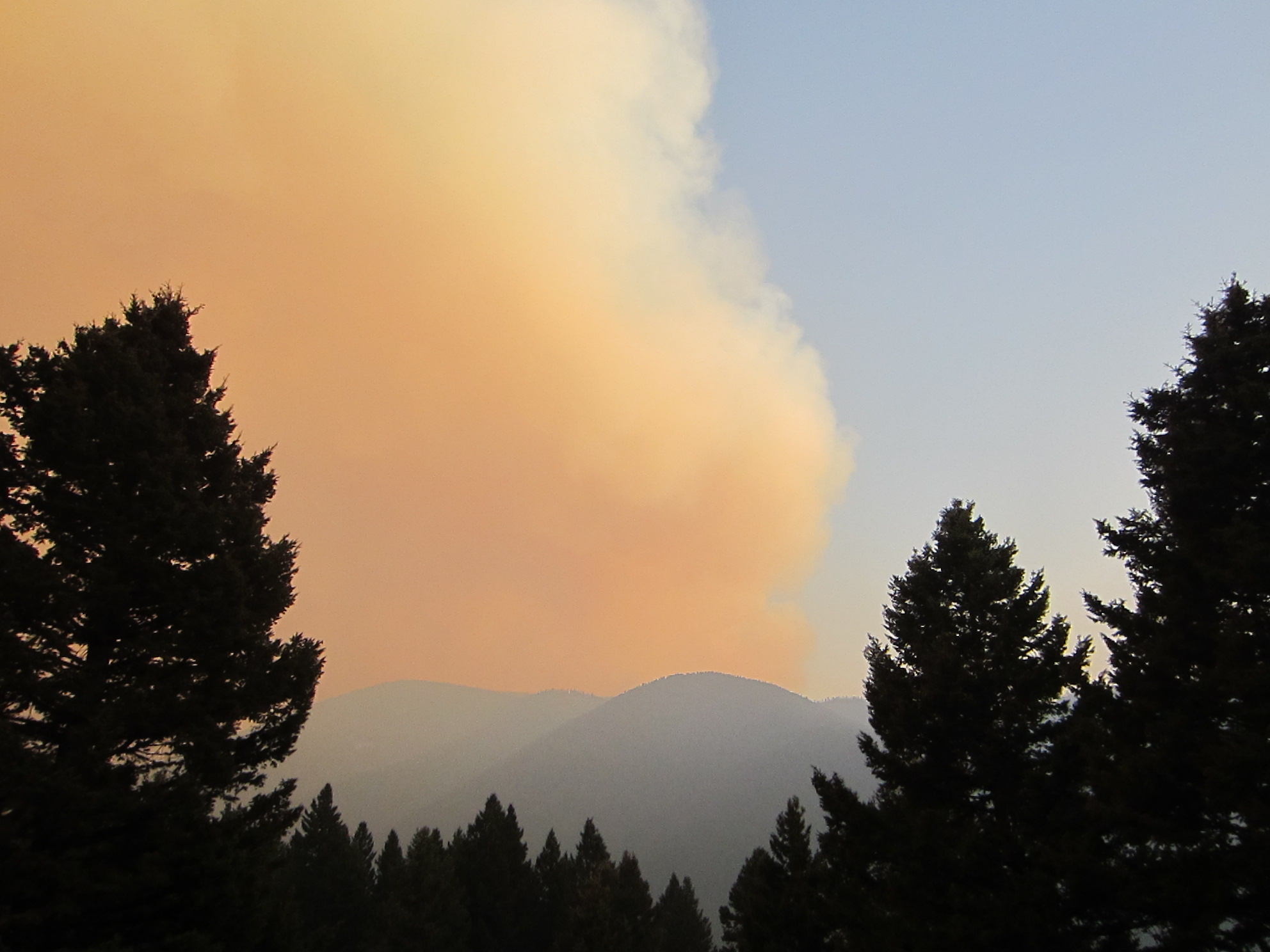
Three weeks ago, on August 28, a fire detection specialist named Steve Christman was riding shotgun in a lightweight Cessna 182 flying over the Gallatin National Forest in Southwest Montana. Below him was some of the most rugged terrain in the Northern Rockies -- the Gallatin Crest, a rocky, heavily timbered crazy quilt of creeks, steep slopes, and 10,000' mountain peaks. Sprawling just a few miles from the resort community of Big Sky, it is a region beloved by hikers and mountain bikers but inaccessible to just about everyone else.
My wife and I spend the summers in a cabin that borders this forest. On a map, you could draw a line south from our porch and hit nothing but trees, rocks, and lakes to Yellowstone and then to the Grand Teton National Forest and Jackson Hole before you hit a paved road. But in a matter of hours after Christman's flight, we were to be engulfed in one of the largest and most public events imaginable. It brought with it acts of astonishing individual bravery, as well as the combined efforts of more than 500 firefighters, and the expense of at least $7 million of federal funds. All of this was produced by a mega-wildfire beguilingly named Millie.
At 2:21 p.m., Christman noticed a single plume of smoke rising from the south slope of Storm Castle Creek. A 25-year veteran of the Forest Service, Christman was not surprised; a lightning storm had rolled through the mountains the previous day. This year's long drought had baked a region already weakened by bug kills into a forest of bones. The moisture content of trees had fallen beneath the requirement for kiln-dried boards sold in a lumberyard. The fire covered less a tenth of an acre, most of it creeping in the ground cover, but Christman immediately radioed for help. "It was in heavy timber and had fairly high potential," he says. "I knew it would take a while to get an engine into it, and we needed to do something or else we'd have a fairly big fire."
At 2:32 p.m., eleven minutes after Steve Christman radioed in his first report, dispatcher Kayla Lemire faxed a request that a Smokejumper team temporarily based in nearly West Yellowstone be flown up to the fire. The request was received by Dan Cottrell, a seamy-faced, deceptively relaxed 38-year-old who has been jumping out of the air into fires on the ground for more than dozen years. Smokejumpers are something like the SEALs of the wildland firefighters (though they would get an argument from the equally highly trained Hotshot crews). They undertake some of the most physically demanding jobs in the federal work force, though Cottrell likes to say that the most dangerous thing he does every day is to drive to work.
By 3 p.m. Cottrell and his stick of eight jumpers were circling over the fire, which by then had grown to a half-acre of flames, mostly on the ground. Cottrell requested a helicopter to bring in the "Bambi buckets," 500-gallon dollops of water scooped from a reservoir and nearby lakes. The Smokejumpers chose a desired landing-spot a half-mile from the fire. They tossed several streamers out of the plane to gauge both wind direction and the best flight path to the LZ. They were carrying four "squares" -- parachutes that work best in high winds -- and four "rounds." After the four squares jumped, they threw another set of streamers -- but now the wind churning up the ridgetops was becoming dangerously turbulent. Cottrell decided reluctantly that he and the other three Smokejumpers would have to return to West Yellowstone and drive back in their truck - a journey of several hours.
Meanwhile, a local fire engine crew stationed at Big Sky had been ordered to the scene by the Forest Service. It would take 90 minutes for them to crawl up the gravel road to the fire. Among the four men aboard Engine 661 was Dan Kettman, a newly trained, 25-year-old rookie fire fighter who was on his first assignment. He had never fought a fire before. "We kept hearing traffic on the radio about the fire," he remembers. "We knew it was growing, and I was starting to feel a little nervous."
Circling overhead in his Cessna, Steve Christman saw that the fire had grown to 30 or 40 acres and was burning rapidly on all sides and up towards a ridgetop. He told the dispatcher that the fire had "a high potential to run."
View of Millie from my porch, August 29
A little before 5 p.m., Dan Kettman and the crew of Engine 661 arrived at the Blanchard Ranch, a private inholding in the national forest with a few guest cabins and horses. They cut the lock to the gate and requested that the owners be notified to take out the horses. They then crossed Storm Castle Creek and took a Forest Service road to an overlook of the drainage. They were startled by what they saw. The fire had grown to 60-75 acres and was generating its own weather system in the treetops. "You could hear trees popping like Roman candles," says Kettman. "It was too close for comfort."
Concluding that they could no longer fight the fire on the ground, and worried about being encircled and entrapped, they backed off. "I was the new guy," says Kettman, "so they had me stand on top of the engine to look and make sure we could get out." As they were backing away, the four Smokejumpers who were first on the fire walked out of the smoking woods.
Kettman and the others were concerned about what wildland firefighters call "a blowup." Here is what Norman Maclean says about blowups in Young Men and Fire:
"The chief danger from a ground fire is that it will become a 'crown fire,' that is, get into the branches or 'crowns' of trees especially where the trees are close together and the branches interlace ... The crown fire is the one that sounds like a train coming too fast around a curve and may get so high-keyed the crew cannot understand what their foreman is trying to do to save them. Sometimes, when the timber thins out, it sounds as if the train were clicking across a bridge, sometimes it hits an open clearing and becomes hushed as if going through a tunnel, but when the burning cones swirl through the air and fall on the other side of the clearing, starting spot fires there, the new fire sounds as if it were the train coming out of the tunnel belching black unburned smoke. The unburned smoke boils up until it reaches oxygen, then bursts into gigantic flames on the top of its cloud of smoke in the sky. The new firefighter, seeing black smoke rise from the ground and then at the top of the sky turn into flames, thinks that natural law has been reversed. The flames should come first and the smoke from them. The new firefighter doesn't know how his fire got way up there. He is frightened and should be."
Steve Christman, still circling overhead and watching the fire gallop ahead, was running low on fuel. When he saw the Engine 661 pick up the Smokejumpers, he dipped his wing in acknowledgment. "When I saw that I knew we would be okay," Kettman remembers.
By 6 p.m., Dan Cottrell was back on the scene, now designated as a Type 3 Incident Commander, the boss of the operation. He reported that the fire was now up to 150 acres, burning ferociously with a wall of flames waving 20-30 feet high. It was making runs through thick timber and up the rocky slopes. Additional resources had been ordered in: Helicopters, air tankers, a Native American Hotshot crew from Ft. Apache, AZ, and an "Air Attack Platform" plane to observe the fire. At 11 p.m., Cottrell reported "significant fire activity" near the Blanchard Ranch. He would soon bed down for the night, anxious about what the next day might bring, especially if the hot, dry weather continued.
Over the next 24 hours, on August 29, this fire -- her sweet name of "Millie" apparently resulted from a dispatcher's typo of "Miller" -- erupted into one of the most devastating conflagrations of the season. Leaping from the dried-out grasses into the crowns of the subalpine and mixed conifers, Millie took a running start and jumped Storm Castle Creek, burning a swathe five miles long and two miles deep, torching and blackening everything in its path and consuming almost 10,000 acres. Firefighters reported large predators in the area - bears and a pack of 20 wolves dislocated by the fire. The largest predator of all, of course, was Millie. Writers describing fires almost inevitably fall back on an atavistic, primordial vocabulary. Fires are a deranged, feline creature -- "crouching," "creeping," "licking," "leaping," and "waiting."
Two deputies from Gallatin County Sheriff's office placed us on "evacuation warning" on August 30. We moved our so-called valuables to a friend's house and took our dog everywhere (in case we were prevented from returning to the house). We visited the fire camp -- or, as the Forest Service calls it -- the ICP (Incident Command Post), a mini-city of 550 souls, many of them living in tents in a former hayfield. By this time the fire had been upgraded to the level managed by the Great Basin Type 2 Management Team -- a group of 30-40 experienced managers who travel around the country providing logistical support -- food, shelter, sanitation, communications, finance, administration, security -- to firefighters on the front lines.
My wife and I feel close to Millie. We have spent the past two weeks in her close company. Our house and those of our immediate neighbors are the closest structures to the fire, which, as I write this, is still burning five miles away -- uncomfortably close to the same distance it moved on its first, intense day of rampage. The amount of energy released in a typical woodland wildfire is comparable to that of a nuclear explosion. Over the past two weeks I learned about about Bambi Buckets, Sky Cranes, torching, and spotting. I talked to people identifying themselves as Fire Behavior Specialists and Fire Meteorologists. I visited the perimeter of the fire, near the spot where Engine 661 picked up the Smokejumpers.
What did I learn? I learned that mega-fires like Millie will become increasingly common in the years to come, as climate-change clears our forests. And I learned that the men and women who fight fires in our country are the best we -- and our government -- have to offer. At one of the public Fire Information Meetings I attended, a local woman from Bozeman stood up and thanked "the foreigners" for the dedication and professionalism they had amply demonstrated at all levels of government -- federal, state, and municipal. Witnessing this, it is difficult to understand why some politicians attempt to curry favor by denigrating the work of these and other public servants.
On September 13, the Gallatin County Sheriff rescinded our Evacuation Warning. On September 14, the Great Basin Incident Management Team turned over management of the fire to the Gallatin National Forest. We can unroll the rugs we had readied for a quick departure. But we are not yet ready to put the photographs back on the wall. Millie still sends up unnerving smoke columns when clumps of trees within the perimeter suddenly burst into flames, as if to remind us that she is still in the building. Current predictions are that she will still be burning until November 1.
